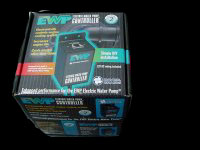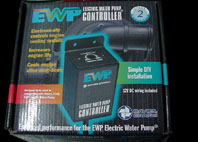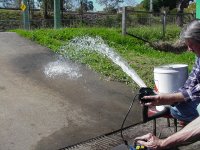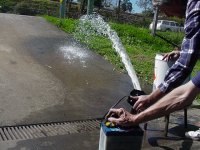|
The Davies Craig Electric Water Pump

 

|
For a turbo charged or race car, I rate the Davies Craig Electric water pump
as the definitive must have, after a good computer!
This baby will not only give you a cheap few
KW. but extend the life of your engine and/or turbo. It is best to
wire it in as option 2 in the instructions. It will then work like a
turbo timer. Start pumping slowly when the engine warms up, pump
faster the hotter it gets and then still keep pumping and circulating water
until the temperature drops to you pre set level. Used in conjunction
with thematic fans - this gives complete ideal water control. It stops
localized hot spots - turbo housing, head passages etc. and will give a more
uniform expansion and contraction of the block and head mating surfaces,
which will prolong head gasket life. A Holden 5 litre water pump drags
up to 15Kw (20 HP) away from the back wheels!! |
Tech Info:-
I wanted some technical answers
to questions I had on the Electric
Pump & Controller before loading this onto our site. I'll give you
the information gained from Davies Craig before my own specs. and
ideas. The following information is straight from talking with Robert
Thompson - Sales Manager, Davies Craig Australia.
I asked the flow ratings of the pump - both free flow and under
pressure- their free flow rate is 80 litres/minute @ 14.5v., and
under pressure, tested in a couple of cars, was only marginally less.
I asked if they have a maximum rating on kilowatts (HP) output and/or
BTU and/or engine size. No they don't, they have performed perfectly
on all cars tested and includes SubarooWRX and Holden VT-SS. He
stated that air flow through the radiator is 5 times more important
then water flow through the engine (- that should help our aluminium
radiator sales!) Water flow is not that decisive on cooling
temperature across a broad parameter.
I asked if the Electric fan/s could be run off the controller unit?
The answer was an emphatic NO. The pump controller is rated at 90
watts and a 16" fan can draw up to150 watts. A controller to handle
that current, would need to be very much larger in size.
I asked how many times per minute/second the controller monitors the
water temp. & adjusts the pump voltage. It is continuously monitoring
& adjusting.
He then described the operation of the pump-
n Nothing happens until 80deg.C
n Between 80degC and 92degC it goes into pulsing mode
n Between 92degC and 95degC it goes into ramping mode
n Above 95deg C, full battery voltage is supplied to the pump
The reversal of the above happens when the engine is switched off,
meaning that your coolant is circulated in decreasing volume, down to
80degC.
He noted that the pump can be run in the existing system- as an `after
cooler' n that it's important to bleed the system properly when
installed. Most cars were simple - but a couple need a bit extra
time, Subaroo WRX being one. They bleed them by jumping battery
voltage straight to the pump and waiting until the air bubbles stop
appearing and then connect controller. n he said that it's also a must
to locate the controller in the cabin, under the dash console, glove
box etc, but keep it out of the heat of the engine bay.
Okay. Now ARE observations.
We did some pump tests an came up with the following. We soldered a
38mm pipe into the very bottom of a 20lite drum. Filled the drum to
15mm below the lid. At the same time, connecting the power lead to a
car battery. The pump was held at .25 height up the drum. Starting
voltage 12.60v 1st 20L - 18.06 secs
2nd 20L - 18.14secs
3rd 20L - 17.68secs
4th 20L - 17.80secs
finish voltage 12.48v - Please not that this was a small battery that
had been replaced.
Average time 17.92secs/20L = 67 litres/min or 14.7gallons/min.
NOTE. This test was conducted with an average battery voltage of
12.57 volts. Your engine running should supply approximately 14.5
volts to the pump so this would increase the flow rate significantly
and come at least close to Davies Craig rating
We also found the pump has absolutely no self priming ability, but
this will be of no consequence if it is fitted lowish in the bottom
hose.
I am a mechanic by trade but have owned Brisbane Radiator Service for
the last 20 years. One thing that has got consistently more obvious
in recent years is when we go and pick a radiator up for a clean out,
more and more times than not, the head is off the vehicle. Cast iron
block- alloy head. These two expand when getting hot at different
rates and contract when cooling, at different rates. The headgasket
is the medium separating the two, so the larger the difference in
expansion/contraction rates, the more chafing of the gasket. This
water pump, set up as example 2 (it will keep pumping until the water
temp. cools to 80deg. C. with the ignition switched off) in the
instructions, has to stabilise the temperature more evenly, especially
on cool down after switching the engine off - heat soak. This is what
causes your engine water temperature gauge to rise before falling,
immediately after switch off. If you have a turbo charger huffing and
puffing into the engine, it's a lot more important again. That turbo
will love you for pumping water through it after shutting down and
it's got to live longer!
|



|
|